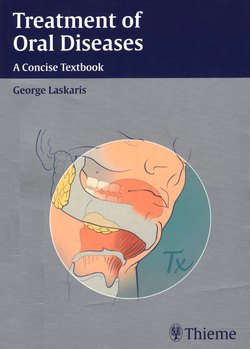Читать книгу Treatment of Oral Diseases - George Laskaris - Страница 12
ОглавлениеActinomycosis
Definition
Actinomycosis is a chronic granulomatous infectious disease.
Etiology
Actinomycosis is caused by the anaerobic Gram-positive bacterium Actinomyces israelii and rarely by other species.
Classification
There are three main clinical types: a) cervicofacial, b) thoracic, and c) abdominal.
Main Clinical Features
Cervicofacial actinomycosis is the most common type (about 50-60% of cases) of the disease and oral lesions form a part of it. The infection typically follows dental infection, tooth extraction, or trauma to the oral mucosa.
Oral Manifestations
•Painless, slow-growing, hard swelling—the classic features of cervicofacial actinomycosis
•Multiple abscesses draining to the surface by sinus tracts. Yellow purulent material representing colonies of Actinomyces (sulfur granules) may discharge from the sinuses
•Scar formation
•New abscesses and sinuses may develop
•Jaw and salivary gland involvement is common
•Trismus is common
•Periapical inflammatory lesions may also occur
•Tongue, buccal mucosa, lips, gingiva, and tonsils are the most common oral sites involved
Diagnosis
The clinical diagnosis should be confirmed by biopsy and histopathologic examination, direct microbiologic examination and culture, and indirect immunofluorescence.
Differential Diagnosis
•Periodontal abscess
•Dental abscess
•Tuberculosis
•Systemic mycoses
•Other infections
•Benign and malignant tumors
Treatment
Basic Guidelines
•The response to treatment is slow.
•Treatment should be continued for weeks or months after clinical cure to avoid recurrences.
•The best therapeutic regimen includes a combination of drugs and surgery.
Suggested Therapies
•Intramuscular penicillin C. 10-20 Mil/day for 4-6 weeks, is the drug of choice for early cervicofacial actinomycosis. This regimen is usually followed by oral penicillin V 500 mg four times daily for I -3 months. Localized, limited disease usually responds well to a combination of surgical removal of the infected tissues and a 2-4-week course of penicillin.
•Tetracycline 500 mg three to four times daily for 2-4 months may be used as an alternative drug for patients allergic to penicillin.
•Intramuscular or intravenous ampicillin 50 mg/kg per day for 4-6 weeks, followed by oral amoxicillin 500 mg/day for 6-12 additional months should be given to prevent recurrences.
•Surgical procedures such as drainage and resection should be also carried out along with the drug therapy for better results.
Alternative Therapy
Sulfamethoxazole 2-4 g/day for 4-6 weeks or more is an alternative regimen.
References
Hirshberg A, Tsesis I, Metzger Z, Kaplan I. Periapical actinomycosis: A clinicopathologic study. Oral Surg Oral Med Oral Pathol Oral Radiol Endod 2003;95:614–620.
Laskaris G. Oral manifestations of infectious diseases. Dent Clin North Am 1996;40:395–423.
Rahnama M, Tomaszewski T. Cervicofacial actinomycosis: An issue still present. Ann Univ Mariae Curie Sklodowska 2001;56:447–449.
Rush JR, Suite HR, Cohen DM, Makkawy H. Course of infection and case outcome in individuals diagnosed with microbial colonies morphologically consistent with Actinomyces species J Endod 2002;28:613–618.
